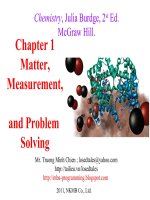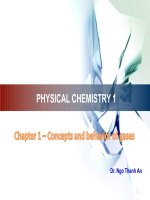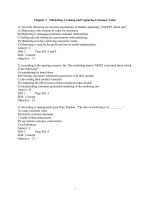Chapter 1: Matter and Measurement
Bạn đang xem bản rút gọn của tài liệu. Xem và tải ngay bản đầy đủ của tài liệu tại đây (667.67 KB, 43 trang )
General Chemistry
Principles and Modern Applications
Petrucci • Harwood • Herring
8th Edition
Chapter 5: Introduction to Reactions in
Aqueous Solutions
Philip Dutton
University of Windsor, Canada
Prentice-Hall © 2002
Slide 1 of 43
General Chemistry: C
Prentice-Hall
Contents
5-1
5-2
5-3
5-4
5-5
5-6
5-7
The Nature of Aqueous Solutions
Precipitation Reactions
Acid-Base Reactions
Oxidation-Reduction: Some General Principles
Balancing Oxidation-Reduction Equations
Oxidizing and Reducing Agents
Stoichiometry of Reactions in Aqueous
Solutions: Titrations
Focus on Water Treatment
Slide 2 of 43
General Chemistry: C
Prentice-Hall
5.1 The Nature of Aqueous Solutions
Slide 3 of 43
General Chemistry: C
Prentice-Hall
Electrolytes
•
•
Some solutes can dissociate into ions.
Electric charge can be carried.
Slide 4 of 43
General Chemistry: C
Prentice-Hall
Types of Electrolytes
• Strong electrolyte dissociates completely.
– Good electrical conduction.
•
Weak electrolyte partially dissociates.
– Fair conductor of electricity.
•
Non-electrolyte does not dissociate.
– Poor conductor of electricity.
Slide 5 of 43
General Chemistry: C
Prentice-Hall
Representation of Electrolytes using
Chemical Equations
A strong electrolyte:
MgCl2(s)
→ Mg2+(aq) + 2 Cl-(aq)
A weak electrolyte:
CH3CO2H(aq) ← CH3CO2-(aq) + H+(aq)
→
A non-electrolyte:
CH3OH(aq)
Slide 6 of 43
General Chemistry: C
Prentice-Hall
Notation for Concentration
MgCl2(s) → Mg2+(aq) + 2 Cl-(aq)
In 0.0050 M MgCl2:
Stoichiometry is important.
[Mg2+] = 0.0050 M [Cl-] = 0.0100 M
Slide 7 of 43
General Chemistry: C
[MgCl2] = 0 M
Prentice-Hall
Example 5-1
Calculating Ion concentrations in a Solution of a Strong
Electolyte.
What are the aluminum and sulfate ion concentrations in
0.0165 M Al2(SO4)3?.
Balanced Chemical Equation:
Al2(SO4)3 (s) → 2 Al3+(aq) +
Slide 8 of 43
3 SO42-(aq)
General Chemistry: C
Prentice-Hall
Example 5-1
Aluminum Concentration:
0.0165 mol Al2(SO4)3
[Al] =
1L
2 mol Al3+
×
1 mol Al2(SO4)3
= 0.0330 M Al3+
Sulfate Concentration:
0.0165 mol Al2(SO4)3
[SO4 ] =
1L
2-
Slide 9 of 43
3 mol SO42×
1 mol Al2(SO4)3
General Chemistry: C
= 0.0495 M SO42-
Prentice-Hall
5-2 Precipitation Reactions
•
•
Soluble ions can combine to form an insoluble
compound.
Precipitation occurs.
Ag+(aq) + Cl-(aq) → AgCl(s)
Slide 10 of 43
General Chemistry: C
Prentice-Hall
Net Ionic Equation
Overall Precipitation Reaction:
AgNO3(aq) +NaI (aq) → AgI(s) + NaNO3(aq)
Complete ionic equation:
Spectator ions
Ag+(aq) + NO3-(aq) + Na+(aq) + I-(aq) →
AgI(s) + Na+(aq) + NO3-(aq)
Net ionic equation:
Ag+(aq) + I-(aq) → AgI(s)
Slide 11 of 43
General Chemistry: C
Prentice-Hall
Solubility Rules
•
Compounds that are soluble:
– Alkali metal ion and ammonium ion salts
Li+, Na+, K+, Rb+, Cs+
NH4+
– Nitrates, perchlorates and acetates
NO3-
Slide 12 of 43
ClO4-
CH3CO2-
General Chemistry: C
Prentice-Hall
Solubility Rules
•Compounds that are mostly soluble:
– Chlorides, bromides and iodides
Cl-, Br-, I-
• Except those of Pb2+, Ag+, and Hg22+.
– Sulfates
SO42-
• Except those of Sr2+, Ba2+, Pb2+ and Hg22+.
• Ca(SO4) is slightly soluble.
Slide 13 of 43
General Chemistry: C
Prentice-Hall
Solubility Rules
•Compounds that are insoluble:
– Hydroxides and sulfides
HO-, S2-
• Except alkali metal and ammonium salts
• Sulfides of alkaline earths are soluble
• Hydroxides of Sr2+ and Ca2+ are slightly soluble.
– Carbonates and phosphates
CO32-, PO43-
• Except alkali metal and ammonium salts
Slide 14 of 43
General Chemistry: C
Prentice-Hall
5-3 Acid-Base Reactions
•
Latin acidus (sour)
– Sour taste
•
Arabic al-qali (ashes of certain plants)
– Bitter taste
•
Svante Arrhenius 1884 Acid-Base theory.
Slide 15 of 43
General Chemistry: C
Prentice-Hall
Acids
•
+
Acids provide H in aqueous solution.
•
Strong acids:
•
Weak acids:
HCl(aq)
→
H+(aq) + Cl-(aq)
CH3CO2H(aq)
←
→
H+(aq) + CH3CO2-(aq)
Slide 16 of 43
General Chemistry: C
Prentice-Hall
Bases
•
Bases provide OH in aqueous solution.
•
Strong bases:
•
Weak bases:
NaOH(aq)
→ Na+(aq) + OH-(aq)
H 2O
NH3(aq) + H2O(l)
Slide 17 of 43
←
→
OH-(aq) + NH4+(aq)
General Chemistry: C
Prentice-Hall
Recognizing Acids and Bases.
•
Acids have ionizable hydrogen ions.
– CH3CO2H or HC2H3O2
•
Bases have OH combined with a metal ion.
KOH
or are identified by chemical equations
+
Na2CO3(s) + H2O(l)→ HCO3 (aq) + 2 Na (aq) + OH (aq)
Slide 18 of 43
General Chemistry: C
Prentice-Hall
More Acid-Base Reactions
•
Milk of magnesia
Mg(OH)2
Mg(OH)2(s) + 2 H+(aq) → Mg2+(aq) + 2 H2O(l)
Mg(OH)2(s) + 2 CH3CO2H(aq) →
Mg2+(aq) + 2 CH3CO2-(aq) + 2 H2O(l)
Slide 19 of 43
General Chemistry: C
Prentice-Hall
More Acid-Base Reactions
•
Limestone and marble.
CaCO3(s) + 2 H+(aq) → Ca2+(aq) + H2CO3(aq)
But: H2CO3(aq) → H2O(l) + CO2(g)
CaCO3(s) + 2 H+(aq) → Ca2+(aq) + H2O(l) + CO2(g)
Slide 20 of 43
General Chemistry: C
Prentice-Hall









